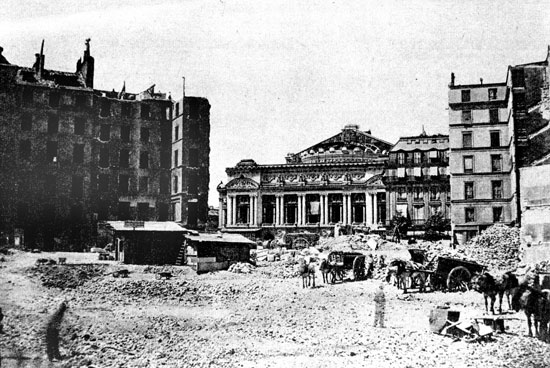Fr : version française / En: english version
Haussmann: Minister of Paris
Paris under construction! In 1850, Paris was transformed into a huge building site for the next 30 years under the watchful eye of Baron Haussmann, the city's civic planner, who had been impressed by the reconstruction work carried out after the Great Fire of 1666 on a visit to London. Under the strict authority of Napoleon III, and driven by the latest thinking on hygiene, Baron Haussmann repossessed, demolished then rebuilt boulevards and buildings in perfectly straight lines, even in the city's historical district. And so the campaign to expand, embellish and clean up Paris (Paris agrandie, Paris embellie, Paris assainie) got under way. In 1860, the neighboring communes of Montmartre, Charonne and Belleville were swallowed up by the capital.
The dawn of public-private partnerships
The work commissioned by Napoleon III and undertaken by Haussmann was extremely costly. To see through the project successfully, the authorities introduced new town-planning regulations on compulsory purchases, easement for reconstruction and turned to the private sector to seek the necessary funding. The government borrowed to finance necessary purchases, utilities and so on (water supply, gas, sewers and parks). It paid back these loans by reselling plots of land suitable for construction to real-estate developers, who were then bound to conform to the new town-planning regulations. The system made it possible to invest twice the city's budget in the monstrous project every year.
However, debts soon mounted and real-estate development swang towards speculation and money-making—an approach criticized by Emile Zola in his novel The Kill.
The creation of large thoroughfares was, in Haussmann's eyes, a means of satisfying increasing traffic demand. The policy gave cars priority—a rule that continued until Georges Pompidou came into office many years later.
A sunny disposition!
The time has come to clean up the insalubrious streets and create more wide-open spaces! The time has come to let the sun stream into the shady districts, to give Paris the lungs to breathe as it should; not for reasons of trend or fashion, but for the sake of hygiene and progress! Yet wherever the interests of public health, wherever the inevitable growth of civilization do not require Parisian dignitaries to display their relentless determination, mercy for the old streets of Paris! Mercy for the visible vestiges of the past that the present is so intent on destroying in every way...! Mercy! If only for a few warts and stains beloved of Montaigne!
Extract from Le Vieux Paris by Louis Blanc in Paris-guide, par les principaux écrivains et artistes de la France, Librairie Internationale, 1867. (Free translation from the French)



























